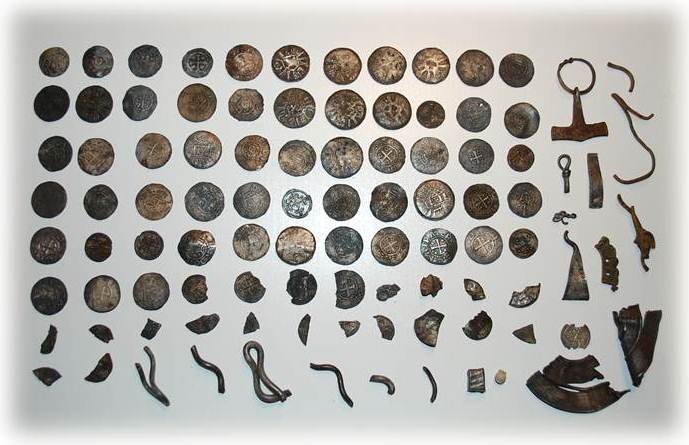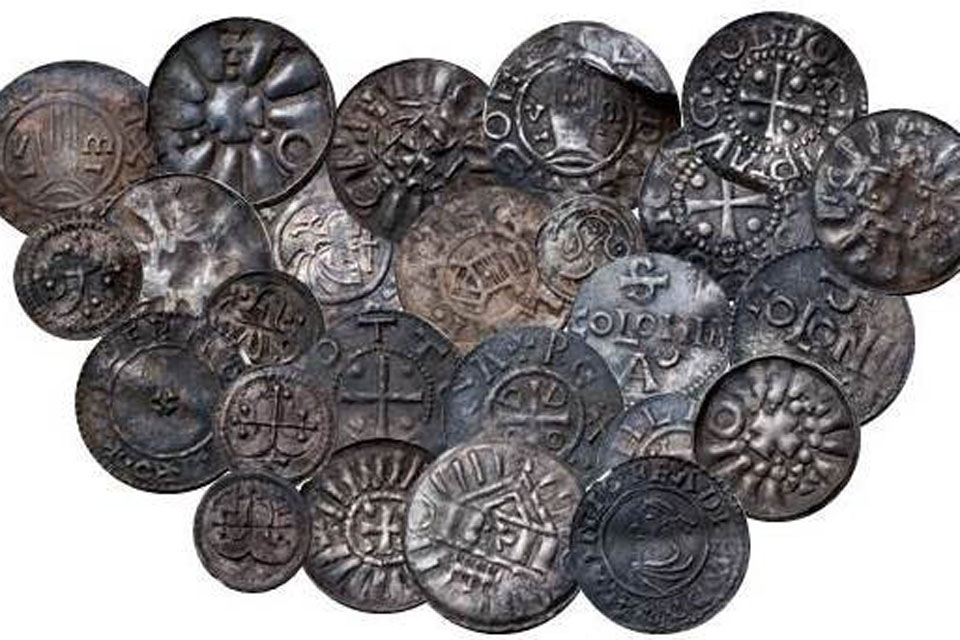Spectacular new find of a Viking hoard in Vendsyssel in the Northern Part of Denmark sheds new light on the coins of Harold Bluetooth
The coins from 10th century Denmark are often called half-bracteates as they are so thin that the stamp on the two sides easily gets mixed up. Another feature is that the content of silver as well as the general weight is low, which means that they are not often found by metal-detectors, thus eluding amateurs as wells as archaeologists.
Yesterday a spectacular find of more than 162 coins plus broken pieces of silver from the 990’es have crated a lot of excitement. Apart from German and Islamic coins the hoard consists of at least 52 so-called Cross Coins. These coins were minted during the reign of Harold Bluetooth (958 – 987), who may have introduced the first nationwide coinage in Denmark. It is generally believed that the king began to mint his new coins around 975 at a time when he may have lost control over the main town, Haithabu, which had a well functioning mint at that time.

The iconography of the crosses are clearly Christian showing on the reverse either one cross created out of four or in some cases three crosses placed on top of a triangle (Golgatha). The coins are believed to reflect the conversion of the king in AD 963 as witnessed on the Great Jelling Stone. According to the inscription here, the king claims to have “ordered this monument made in memory of Gormr, his father, and in memory of Thyrvé, his mother; that Haraldr who won for himself all of Denmark and Norway and made the Danes Christian.”
Obviously, the coins were meant as part of the king’s effort to market his new religion.
However, one of the intriguing facts about the coins of Harold Blutooth is that they seem to have disappeared rather quickly after the takeover of his son, Sveyn Forkbeard. Some have hypothesised that the disappearance was due to the fact that the new king, who lead a rebellion against his father, in later sources was claimed to have turned heathen again and hence worked to call the coins in. Other scholars believe that the coins have simply left so few traces in the earth due to their fragile character.
Maybe the detailed study of the newfound coins can help to shed some light on this conundrum, since German coins date it to the 990’es, when Sveyn was busy planning his later take-over of Norway and England. Whatever the future conclusions, it is an intriguing fact that the hoard apart from the coins also contained a silver Thorshammer, a miniature replica of Mjolner, the famous axe belonging to the God Thor.
According to the archaeologist-in-charge, Sidsel Wåhlin from Vendsyssel Historical Museum, the next step – apart from studying the hoard – is going to see if it is possible to locate a nearby Viking farm, which might have been home to the very wealthy viking, who deposited the coins in the field.
Follow the activities at Vendsyssel Historical Museum’s Facebook
READ MORE:
Silver Economies, Monetisation and Society in Scandinavia AD 800-1100
Ed. by Redigeret af James Graham-Campbell, Søren Michael Sindbæk og Gareth Williams
Århus Universitetsforlag 2011
ISBN 978 87 7934 585 0
King Harold’s Cross coinage. Christian coins for the merchants of Haithabu and the king’s soldiers (Working Title)
By Jens Christian Moesgaard with the collaboration of Maria Filomena Guerra and Gitte Tarnow Ingvardson and contributions from Lutz Ilisch, Peter Ilisch, Peter Pentz and Hans Skov. In series: Publications of the National Museum Studies. Published by University Press of Denmark (In Press)
Hedeby og den danske kongemagt i 900-tallet – mønternes udsagn [Haithabu and the Danish monarchy in the 10th century.Numismatic evidence]
By Jens Christian Moesgaard
In: KUML 2012, s. 111-136 [English summary s. 135-136]
Opsigtvækkende fund af korsmønter. Er hypotesen om ’Tyskervældet’ i Hedeby 974-983 forkert?
Volker Hilberg og Jens Christian Moesgaard
I: Nordisk Numismatisk Unions Medlemsblad, 2010. s. 143-150.
Harald Blåtands “jellingemønter” ca 975 -985.
Af Jens Christian Moesgaard.
In: Nordisk Numismatisk Unions Medlemsblad 2009: 2.
Hvorfor er der så få enkeltfund af Harald Blåtands mønter?
Af Jens Christian Moesgaard.
In: Nordisk Numismatisk Unions Medlemsblad, 2009 s. 135-139
SEE MORE:
Photos of the hoard
READ ALSO:
